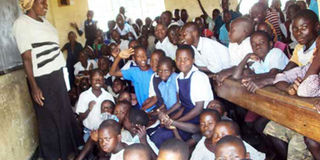Why focus is on science teachers

A teacher in the classroom
What you need to know:
- Congestion in UPOLET schools was high with some schools accommodating more than 90 students in a class yet the policy is 40 students per class.
- A teacher at Ngarama SS in Isingiro District told me that the school’s student enrolment stands at 400, with only four science teachers, inclusive of the head teacher and his deputy on government payroll.
Teachers are vital in the education system of any country. The education system of a country forms the foundation for its development. The government White Paper on Education(1992) highlighted the potential role of science and technology in enhancing development. It was argued that since obtaining independence in 1962, Uganda has largely promoted humanities subjects producing large numbers of white-collar workers. This is linked to the shortage of doctors, engineers, and agricultural researchers, among others.
Development has a lot to do with advancement of science and technology. This explains government’s policy on science education that took effect in 2006. The policy made the study of science subjects - Biology, Chemistry, Physics, and Mathematics compulsory at O-Level. This is intended to bridge the gap by training more scientists. Training more scientists requires more science teachers.
I don’t intend to discuss the salary disparity between science teachers and their arts subjects counterparts and/or diminish the idea of increasing salary to an attractive amount. Rather I am emphasising the need to recruit more science teachers.
Statistics by the Ministry of Education based on the research conducted in January 2013 titled ‘The Department of Secondary Education; The Secondary Sub-sector’, argued that students’ enrolment at secondary level stood at 1,258,084, and it was growing at an average of 3 per cent per annum.
In July 2016, the statistics by the Ministry of Education based on research ‘Results of the Universal Secondary Education (USE)and Universal Post O-Level Education and Training (UPOLET) National Head Count Exercise’ conducted on July 19, 2016, put the number of students under UPOLET at 952,984. If this enrolment was growing a rate of 3 per cent (based on the research in 2013) then this would bring the enrolment of UPOLET students to 1,104,770 after five years (from 2013-18). If we abide by the policy, which requires a student to teacher ratio of 1:40, it implies that the number of science teachers would be 27,620.
The research by the National Head Count Exercise conducted on July 19, 2016, further reveals that among the reasons cited for the drop recorded in the continuing student numbers, was shortage of teachers in some USE schools to enable effective teaching and learning, especially in the rural areas. Congestion in UPOLET schools was high with some schools accommodating more than 90 students in a class yet the policy is 40 students per class. It was recommended that the government needs to invest more in school infrastructure, teaching staff and learning materials so as to match the demand for secondary education.
A teacher at Ngarama SS in Isingiro District told me that the school’s student enrolment stands at 400, with only four science teachers, inclusive of the head teacher and his deputy on government payroll.
John Kiwanuka.
[email protected]




